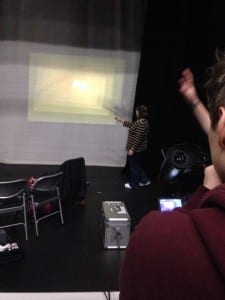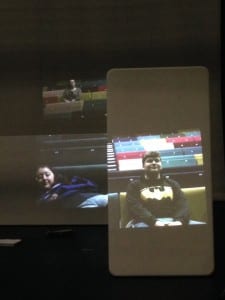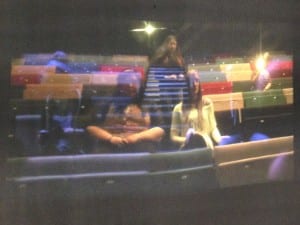Give me a camera and a projector and honestly I’m like a kid at Christmas. I can get very easily excited over multimedia theatre, it’s something I’ve taken interest in since I started taking drama seriously, so being able to just have some time to ‘create’ is something I treasure.
This week we were allowed to do just this. As a group we were given two cameras and two projectors and let loose to see what we could do with live feeds. Steve Dixon wrote, “for many performance artists” including us, “digital technologies remain tools of enhancement and experimentation.” (Dixon, 2007, 8) Experimentation is what we were aiming for, and that is what we did.
Portals to the past.
One way of using the projectors and cameras is by facing the camera directly at a projection of what it is feeding out. This creates a similar effect to that of a hall of mirrors. Where the same image will be reflected back indefinitely.

However, one interesting factor that makes the introduction of media to this is that a live feed will always have a small delay. When someone walks or moves in the eye of the camera, their projected twin will copy a short time after, and so on through each image. This could lead to an interesting take on performing with yourself. Especially if one was to try and catch themselves looking back at them…
Big Student, Little Student.
One very interesting way of using one projector to get multiple projections is careful placement of set pieces. By taking a flat and placing it in a certain place further forward to another flat, you can create what feels like two different screens, projecting the image at two different sizes. With careful placement of actors and clever flat placement you can create an image that closely resembles that of a giant and child.

The same can be done again with however many different screens you want.



Ghost of Multimedia Past.
The experimentation becomes far more interesting when you create something you have never seen before. Using the room we were in, we found two parts that looked reasonably the same, and had each camera facing these parts. By placing the projectors on top of one another facing the same screen, we could emulate the feeling of ghosts walking around a space, as nobody would be fully visible.



This was a clear demonstration of intermediality, as no part of this performance would work without the other. Similarly, you would not be able to view just one side of the performance. The performance came from both seeing the actors in the different spaces, the set up, and the eventual projection. It was in this inbetween space that the true performance lay.
Oh yeah, and it got even nicer when you add coloured filters to the camera lenses.

Works Cited
Dixon, Steve (2007) Digital Performance: A History of New Media in Theatre, Dance, Performance Art and Installation. Chapter 1. Cambridge and London: MIT Press
